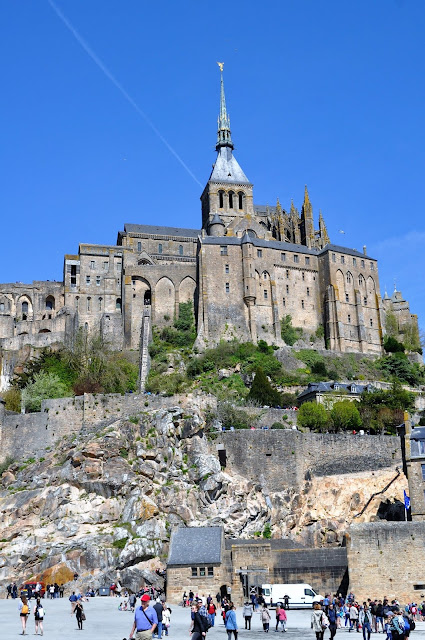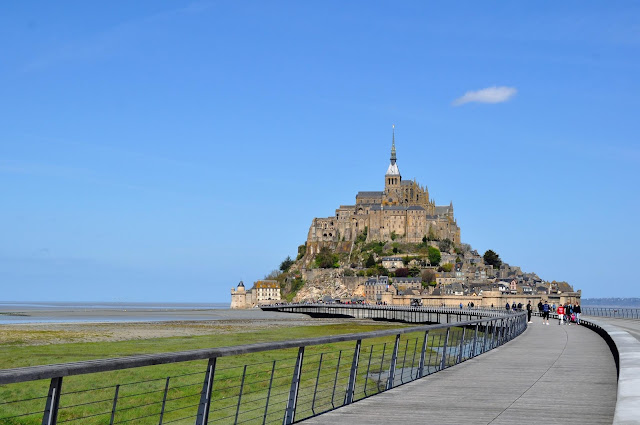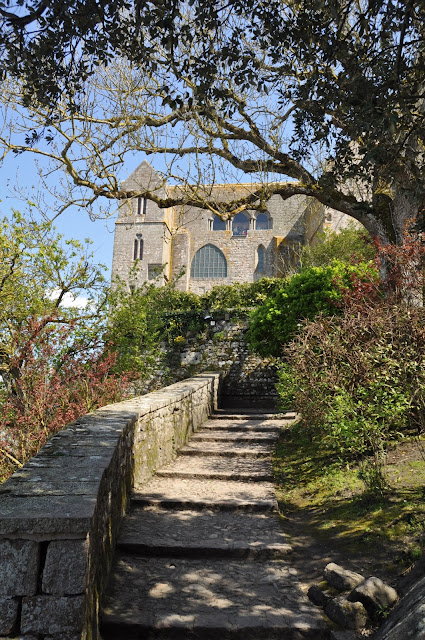2018 and with a love of French history and architecture, I returned to Mont St Michel for the second time. This time with my Welsh One and our route was through winding lanes surrounded by fields in surprisingly flat countryside. In contrast, Mont St Michel appeared in the distance, steel grey with pointed rooftops against an azure sky.
It was like a beacon drawing us closer and I couldn't help but think of what Medieval pilgrims must have made of this sight for the first time and how awestruck they must have been. At that time the Mount was even more difficult to reach. The shore was 4 miles away and it could only be reached at low tide by walking over the bay's clay-like sand, avoiding pools of quicksand as they went. Or if they got their timings wrong then a tide might come sweeping in at 200 feet per minute and take them with it. In the year 1318 alone, eighteen pilgrims drowned in the bay and another dozen died in the quicksand.
To be a pilgrim in the middle ages was to forego the pleasures of life, wear clothes of the poor and eat plain food while taking long and difficult journeys, which could take many months to complete while spending long hours in prayer and fasting. Even after facing these trials the travelling in itself could be a dangerous undertaking with shipwreck and attack by pirates at sea and bandits overland lying in wait real possibilities.
The Abbey was a special feat of medieval engineering and was constructed upwards instead of outwards with the vertiginous chapel sitting on the very top. Once we had parked we took the route along the river Couesnon until we reached the dam completed in 2009. From there we joined the spectacular walkway finished only four years ago that leads across the sands to the Mount.
After climbing a steep path to the side of the Mount's busy centre we reached the entrance to the Abbey. Through an archway that led into the building, more steps led us to the very top of the Mount and enjoyed for a moment the views across the coastline with Brittany to the west and Normandy to the east. Below us were the rooftops of the Mount's village and above us on the top of the spire was the gilded copper statue of the warrior angel St Michael with sword held aloft and his heel crushing a dragon.
Beyond the chapel, we visited the richly decorated and serene cloister with its double row of delicately carved arches, designed for prayer and meditation it still lends itself to quiet contemplation.
Below we entered the vast space of the chevalier chamber, held up by two enormous pillars it would originally have been heated by two enormous fire places. I looked around and wondered whether the room would once have been full of medieval knights, clanking spurs, sweat steaming off them, planning defensive action against invaders? Were the fires lit at night with minstrels playing and were rousing speeches made? Then I discovered afterwards it was the work and study room of the monks. From a fabulous blog post on marielebert I found out about Mont St Michel's manuscripts, some of which may well have been worked on in this room.
Transcribed onto parchment, made from sheepskin, goatskin or vellum (calfskin) the ink was made from charred wood or carbon black and the binder would have been made from honey or Arabic gum. At one point Fifteen scribes would have been transcribing thousands of pages in silence at the same time, taking extreme care over their work, and with a constant search for perfection and harmony. "After the relics of saints a library — that is to say a few books in a cabinet — was the greatest treasure of an abbey. The scriptorium gave birth to thirteen manuscripts, copied from manuscripts lent by other abbeys in order to create new manuscripts for worship and study....the oldest of which (from Mont St Michel) dates back to the eighth century, and the more recent from the fourteenth century. Of these 199 manuscripts, seventy manuscripts were produced in the Mont Saint-Michel Scriptorium."
During the French Revolution, this special collection was requested by the authorities to be moved to the mainland at Avranches. By this time In 1791, the library consisted of 3,550 books of (including the 299 manuscripts). Under the supervision of the National Guard, the books were taken by cart through the sand strands of the bay to reach the mainland. The Mount now began to be used as a prison, holding 14,000 prisoners between the years 1793 - 1863.
Being in Normandy, he visited Mont St. Michel, a fortress built on a rock which stands a league and a half from the coast of Normandy. The tide covers this space twice every twenty-four hours; but when it is low-water, a person can pass over on foot. After having seen the precious relics of the abbey, the square buckler, and the short sword found in Ireland near the body of the well-known dragon, whose destruction is attributed to the prowess of St. Michel, Mons. de Chartres was conducted, through many labyrinths, to the subterraneous parts of the edifice; where he was shewn a wooden cage, which was made by order of Louis the Fourteenth, for the punishment of an unfortunate wit, who had dared to ridicule his conquests in Holland, no sooner gained than lost. Mons. de Chartres beheld with horror this instrument of tyranny, in which prisoners were still frequently confined; and, expressing in very strong terms his indignation, he was told, that, as a Prince of the blood, he had a right, if he thought proper, to order the cage to be destroyed. Scarcely were the words pronounced, when the young Prince seized a hatchet, gave the first stroke himself to this execrable machine, waited to see it levelled with the ground, and thus may claim the glory of having, even before the demolition of the Bastile, begun the French revolution. LETTER V
Further into the Abbey we entered the refectory where monks would have eaten in silence while listening to a designated monk who would read to them from the pulpit. We also went through a room where former residents were interred afterlife, the room looked empty and in the shade, it felt icy cold. Outside, in contrast, we found the Abbey's garden a peaceful place in the shade of the high walls of the Abbey.
Finally, near the exit to the Abbey, we came across an enormous fireplace set against the exterior of the wall. We couldn't agree whether this was an early heating system or some sort of beacon to raise the alarm against attack. Whatever its purpose, what was clear was that the blackened wall showed that it had been used at some point.
We wound our way back around down the Mount along the wall rampart, tempted as we went by the many eateries along the route.
I hadn't yet seen the street from my childhood memory but as we turned a corner and headed down an alleyway we found the street I had dreamt of seeing again.
Click here to find out more about Mont St Michel and the bay.
Happy travels
Sarah xx
 |
Sarah Agnew
Blogger, Modern Bric a Brac
|
To find out about the best places to eat in Brighton and London plus beautiful places to visit, click here to Follow my blog with Bloglovin












